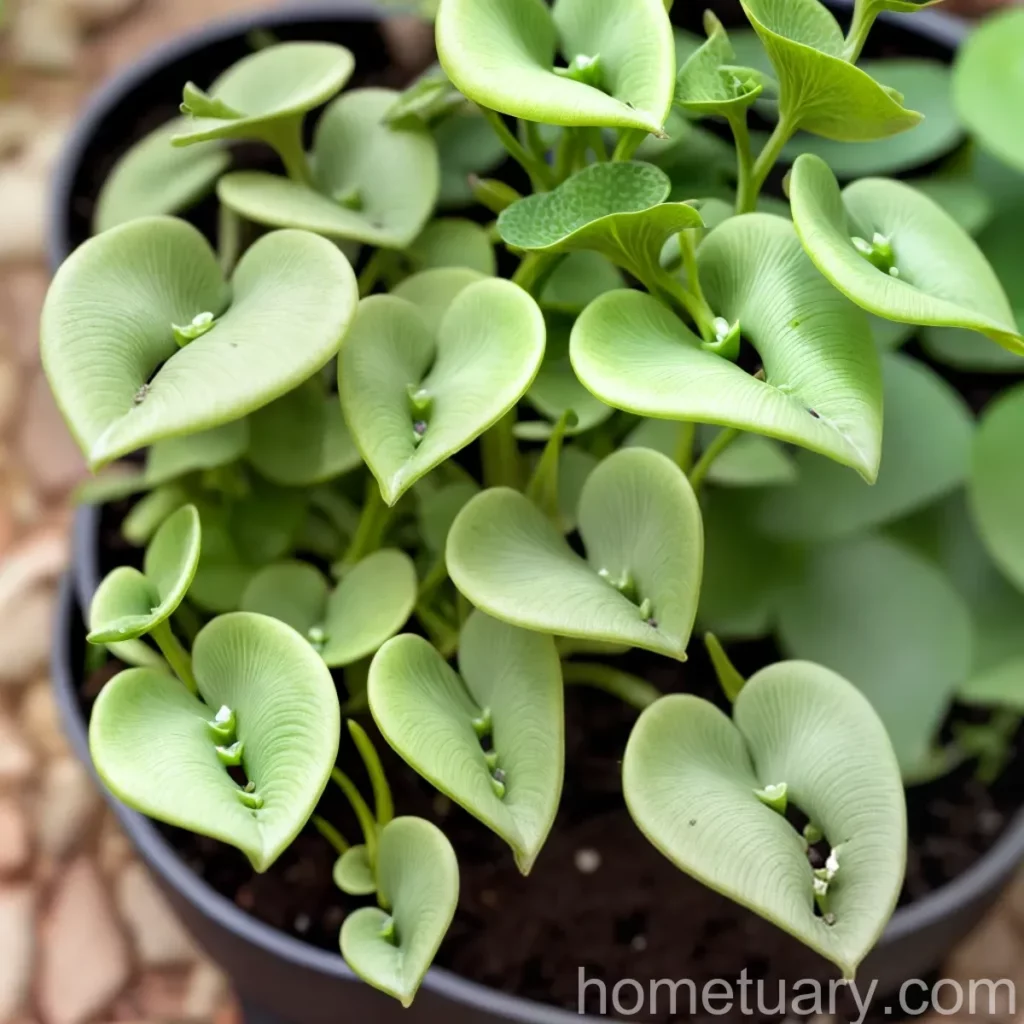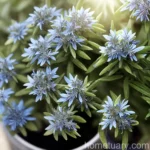Navelwort (Omphalodes cappadocica ‘Starry Eyes’): A Complete Guide to Care, Cultivation, and Uses
Plants have been an integral part of human life for centuries, providing food, medicine, and beauty. Among the diverse array of plant species, navelwort (Omphalodes cappadocica ‘Starry Eyes’) stands out for its captivating appearance and versatility. In this comprehensive guide, we will delve into the characteristics, cultivation, and various uses of navelwort, providing valuable insights for plant enthusiasts, gardeners, and horticulturists.
What Is Navelwort (Omphalodes cappadocica ‘Starry Eyes’)?
Navelwort, scientifically known as Omphalodes cappadocica ‘Starry Eyes’, is a herbaceous perennial plant belonging to the Boraginaceae family. It is native to the mountainous regions of Turkey and the Caucasus. This plant is renowned for its dainty, star-shaped blue flowers that adorn the foliage during the spring, creating a mesmerizing display. The cultivar ‘Starry Eyes’ is particularly esteemed for its striking variegated foliage, accentuating the charm of this ornamental plant.
Navelwort is sought after for its ability to thrive in shaded areas, making it a valuable addition to woodland gardens, shaded borders, and rock gardens. Its low-growing habit and delicate blooms make it an enchanting ground cover, adding a touch of elegance to its surroundings. With its attractive appearance and ease of cultivation, navelwort has gained popularity among gardeners and landscape enthusiasts seeking to introduce a captivating element to their outdoor spaces.
Key Takeaways: Navelwort (Omphalodes cappadocica ‘Starry Eyes’)
Before delving into the details of navelwort’s cultivation and uses, here are the key takeaways that summarize the essential aspects of this enchanting plant:
- Navelwort (Omphalodes cappadocica ‘Starry Eyes’) is a herbaceous perennial known for its dainty, star-shaped blue flowers and variegated foliage.
- It thrives in shaded areas and is often used as a ground cover in woodland gardens and rockeries.
- The cultivar ‘Starry Eyes’ is particularly prized for its striking variegated leaves, adding to its ornamental value.
With a glimpse of the plant’s unique features, let’s explore the essential aspects of cultivating and caring for navelwort to ensure its optimal growth and development.
Culture
Uses
Navelwort (Omphalodes cappadocica ‘Starry Eyes’) offers a myriad of uses, ranging from ornamental to practical applications. Some of its primary uses include:
-
Ornamental Purposes: Navelwort is primarily cultivated for its ornamental value, serving as a captivating ground cover in various garden settings. Its delicate blue flowers and variegated foliage add visual interest to shaded areas, enriching the overall aesthetic appeal of the landscape.
-
Shaded Gardens: Its preference for shaded environments makes navelwort an ideal choice for landscaping shaded gardens, woodland areas, and other low-light settings. Its ability to thrive in such conditions allows for the creation of visually striking displays in areas that are often challenging to adorn with vibrant floral showcases.
-
Erosion Control: Due to its low-growing and spreading nature, navelwort can also be utilized to control erosion on slopes and embankments. Its dense foliage assists in stabilizing the soil and preventing erosion, while its delicate blooms contribute to the visual enhancement of the landscape.
Water
Navelwort, particularly the ‘Starry Eyes’ cultivar, thrives in moderately moist soil with good drainage. While it prefers a consistently moist environment, it is essential to avoid waterlogging, which can lead to root rot and other detrimental conditions. During periods of prolonged drought or intense heat, regular watering is necessary to maintain optimal soil moisture levels. However, it is equally crucial to prevent overwatering, as excessive moisture can compromise the plant’s health.
Sunlight
As a shade-loving plant, navelwort flourishes in partial to full shade. It exhibits increased susceptibility to sunscald and heat stress when exposed to direct sunlight for extended periods. Therefore, it is best suited for areas with limited sunlight, such as under the canopy of trees, along shaded pathways, or in the vicinity of structures that provide shade.
Fertilizer
Navelwort generally thrives in fertile, well-draining soil that is rich in organic matter. Incorporating a balanced, slow-release fertilizer into the soil during the plant’s active growth stages can promote healthy foliage and prolific flowering. However, it is important to refrain from excessive fertilization, as navelwort may be sensitive to high levels of certain nutrients. To prevent the risk of fertilizer burn or nutrient imbalances, it is advisable to follow the recommended application rates and schedule for the specific type of fertilizer used.
Soil
Navelwort prefers a rich, moist, and well-draining soil with a slightly acidic to neutral pH. The inclusion of organic matter, such as compost or well-rotted manure, can enhance the soil’s structure and fertility, creating an optimal growing medium for the plant. Additionally, the soil should have good aeration and water retention capabilities, ensuring that the plant’s root system receives adequate oxygen and moisture.
Pruning
Pruning navelwort is primarily focused on maintaining its compact growth habit and removing spent blooms to encourage continuous flowering. The following pruning guidelines are recommended:
-
Deadheading: Regular deadheading of faded flowers can prolong the blooming period and stimulate the development of new blooms.
-
Thinning: Periodic thinning of overcrowded or sprawling foliage can help maintain the plant’s shape and promote air circulation, reducing the risk of disease and pest infestations.
-
Rejuvenation: If the plant exhibits excessive legginess or decline in vigor, rejuvenation pruning can be conducted in early spring by lightly shearing the foliage to encourage new growth.
Propagation
Navelwort (Omphalodes cappadocica ‘Starry Eyes’) can be propagated through several methods, including division, seed sowing, and stem cuttings. Each propagation technique offers unique advantages and considerations, providing flexibility for gardeners and horticulturists in expanding their navelwort population.
-
Division: Dividing mature clumps of navelwort in early spring or fall allows for the creation of new plants while rejuvenating the parent plant. The divided segments can be replanted in suitable locations, where they can establish and develop into independent specimens.
-
Seed Sowing: Collecting and sowing navelwort seeds in a well-prepared seedbed or containers provides an opportunity to propagate the plant on a larger scale. Sowing seeds in a controlled environment allows for the nurturing of young seedlings, which can later be transplanted into desired areas of the garden.
-
Stem Cuttings: Taking stem cuttings from healthy, established plants and rooting them in a favorable growing medium provides a reliable method of propagation. This approach facilitates the production of genetically identical clones of the parent plant, ensuring the preservation of specific traits and characteristics.
Container Popularity
Navelwort, particularly the ‘Starry Eyes’ cultivar, is well-suited for container gardening, adding a touch of charm to outdoor spaces, patios, and balconies. Its compact growth habit and attractive variegated foliage make it an excellent choice for container plantings, allowing individuals with limited garden space to enjoy the beauty of navelwort.
Container Common Diseases
When cultivated in containers, navelwort may be susceptible to certain diseases that are associated with confined growing conditions. Common diseases that can affect navelwort in containers include:
-
Root Rot: Overwatering or poor drainage in containers can lead to root rot, causing gradual decline and discoloration of the plant’s foliage.
-
Powdery Mildew: Humid environments and inadequate air circulation in containers can create conducive conditions for powdery mildew to develop on the plant’s leaves, resulting in a powdery, white fungal growth.
-
Botrytis Blight: Excessive moisture and high humidity levels in containers can contribute to the onset of botrytis blight, characterized by the appearance of brown lesions and decay on the plant’s tissues.
Disease Diagnosis
Diagnosing and addressing diseases affecting navelwort in containers involves vigilant monitoring of the plant’s health and implementing appropriate measures to mitigate the identified diseases. Visual indicators, such as discolored foliage, leaf spots, or powdery coatings, can provide valuable clues regarding the presence of diseases. Conducting regular inspections and promptly addressing any signs of disease can prevent the spread of pathogens and preserve the plant’s vitality.
Common Pests
Navelwort in containers may be susceptible to pest infestations, with certain pests posing a risk to its health and vigor. Common pests that can affect navelwort in containers include:
-
Aphids: These small, sap-sucking insects can congregate on the plant’s tender shoots and foliage, causing distortion of the leaves and excretion of sticky honeydew.
-
Spider Mites: Infestations of spider mites can result in stippled, discolored foliage and the formation of fine webbing on the plant’s surface.
-
Snails and Slugs: These mollusks can feed on the tender foliage of navelwort, causing irregular holes and damage to the leaves.
Botanist’s Tips
To effectively care for navelwort in containers and mitigate the risks of diseases and pest infestations, the following tips and practices are recommended:
-
Optimal Drainage: Ensure that the containers have adequate drainage holes to prevent waterlogging and maintain proper soil moisture levels.
-
Air Circulation: Promote air circulation around the containers by spacing them appropriately and avoiding overcrowding, thereby reducing the risk of fungal diseases.
-
Regular Monitoring: Routinely inspect the plants for signs of diseases and pests, intervening promptly to address any issues and prevent their escalation.
-
Selective Pruning: Conduct selective pruning to eliminate diseased or infested foliage, reducing the chances of disease spread and pest infestation.
With these specialized insights, gardeners and enthusiasts can effectively cultivate navelwort in containers and ensure the plant’s well-being within this distinct growing environment.
Fun Facts
Experience the intrigue of navelwort through these captivating and informative fun facts:
-
Historical Significance: Navelwort has a historical association with medicinal uses, with its name “navelwort” stemming from the belief that the plant could heal umbilical disorders.
-
Traditional Symbolism: In certain cultures, navelwort has been regarded as a symbol of good fortune, adorning gardens and landscapes as a harbinger of positive energy and prosperity.
-
Wildlife Attraction: Navelwort’s delicate blooms can attract pollinators such as bees and butterflies, contributing to the ecological diversity of its surroundings.
-
Edible Flowers: The edible flowers of navelwort can be used to add a touch of color and flavor to culinary creations, showcasing the versatile nature of this enchanting plant.
With a wealth of fascinating facts, navelwort (Omphalodes cappadocica ‘Starry Eyes’) stands as a botanical marvel, evoking wonder and appreciation for its distinctive attributes and historical significance.
Links to External Resources
For further exploration and in-depth information on navelwort (Omphalodes cappadocica ‘Starry Eyes’) and related topics, consider the following external resources:
- Royal Horticultural Society: Omphalodes
- Missouri Botanical Garden: Omphalodes cappadocica ‘Starry Eyes’
- The American Horticultural Society: Gardening Advice – Navelwort
These resources provide valuable insights, cultural information, and practical guidance on the cultivation and care of navelwort, enriching the understanding of this captivating plant.
In summary, navelwort (Omphalodes cappadocica ‘Starry Eyes’) encompasses a blend of ornamental beauty, historical significance, and practical versatility, making it a captivating addition to diverse garden landscapes and container plantings. With careful cultivation and appreciation for its unique attributes, navelwort continues to captivate the hearts and minds of plant enthusiasts and horticultural enthusiasts alike.
In this comprehensive guide, we have covered the botanical intricacies of navelwort, offering an in-depth exploration of its characteristics, cultivation, and uses. From its historical significance to its contemporary applications in gardens and containers, navelwort stands as a testament to the enduring allure of plant life and the rich heritage it embodies. Whether adorning shaded corners with its exquisite blooms or gracing containers with its variegated foliage, navelwort (Omphalodes cappadocica ‘Starry Eyes’) continues to enchant and inspire, inviting us to embrace the beauty and diversity of the botanical world.















